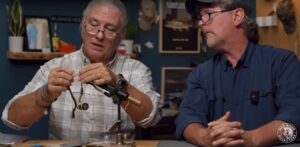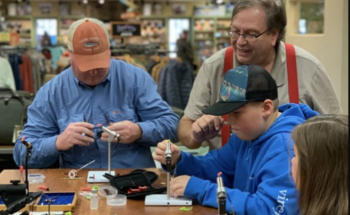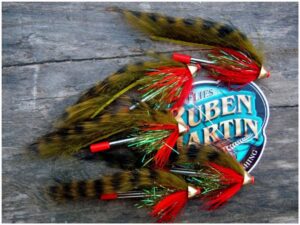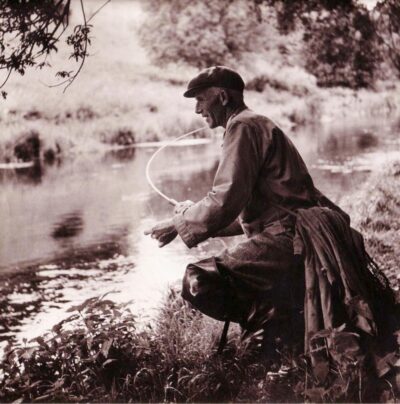
Your budget for flies this month!
Maybe tying flies is not about money

Skip Clement Rehoboth Beach August 2023 . . .
By Skip Clement
Concluding, probably 24 years ago, that exactness does not make a fly potent. That belief carried me into the new millennium, brimming with confidence.
Tying a fly looking like a crippled ‘morsel’ of an aquatic homey is possibly better – including terrestrials. Baitfish and emergers also come to mind as tied as crippled and have proven to work well. Many classic flies are tied as cripples, another encouragement.

Tim Flager [L] with Brian Flechsig, owner of Mad River Outfitters.
A league of their own
Does that always mean the fly tied should not be of a caliber equivalent to Matt O’Neal, Tim Flagler, Kelly Galloup, April Vokey, Steve Hudson, Ruben Martin, or others with similar unique abilities? No, of course not. It is just that most tiers are not big league or even minor league. They are just in a league of their own: capable amateur fly tiers that get it done and do not always get out-fished by those playing with artfully authored flies.

Tying the Bream Buster fly catches the attention of anyone with a drop of curiosity about tying. Steve Hudson, fly-tying editor, looks on with care and pure enjoyment—Hudson photo.
It is about getting it right
It would be fair to say that a fly that is proportionally way out of whack is not a crippled anything; it is a fly with no hope of proving it has worth. A fly tied so it swims as if a spinning top, at a steep angle, or has a hook too big or too small is also a fly with little chance of being successfully used as intended.
It is not about perfection
It has not seemed to matter whether pursuing a saltwater species like a South Florida Everglades National Park snook or bluefish in Greenport, New York, if the fly is a scruffy looking sand eel or one of perfection, either could likely be consumed with zeal.

Dragonfly illustration by award-winning watercolorist Thom Glace.
It is not one size fits all
An aesthetically imperfect #18 Griffith’s Gnat variation fly, rated as such against Matt Neal’s version, would likely be accepted in any freshwater venue. Assuming it was presented properly in a likely coordinate for a predictable species.
Griffith’s Gnat
For example, an Alaskan rainbow in the Kvichak River or an Atlantic salmon in the Grímsá of Iceland, fished equivalently sub-surface, could give equal prominence to Matt’s #18 Griffith’s Gnat variation.

Coastal cutthroat trout fresh from the ocean. A Thom Glace illustration.
Those are tempered statements, of course
A 9-inch sailfish fly, well-tied or gangly, will not catch a brown trout in Georgia’s Chattahoochee River, but it could quickly empty a trout-laden pool. Savage Flies’ variation of the Griffith’s Gnat will tempt not a 36-inch schooled Montauk, New York, striper, but could a 36-inch Salmo salar.

Ruben Martin – tube flies.
Spindle-shanked?
Some will say that any fly tier that is not very good, tying only spindle-shanked flies, is good to go, and their versions are as catch-worthy as aristocratically mannered flies tied by the exceptionally artistic. Maybe, but probably not.
Purpose makes anyone’s life a better one
In any event, it is just fun and rewarding to tie flies and catch fish with them. The joy is personal and real. It’s always hard to feel good about things, so jump in. Tieing is pure jollification.
Matt O’Neal shows how to tie and catch. Contact info within video


